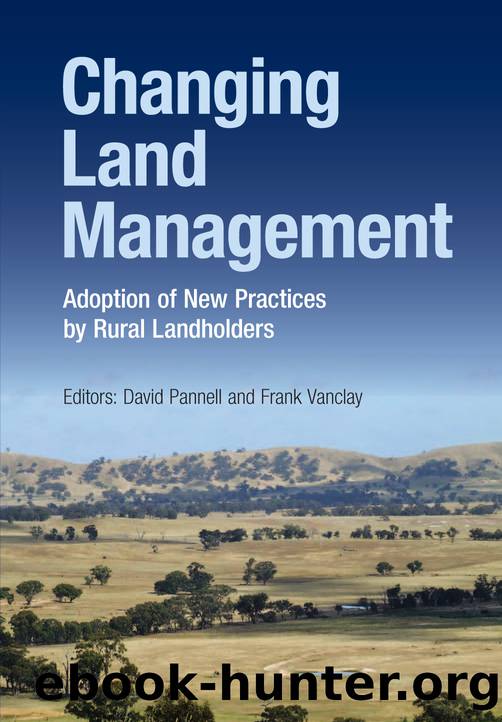Changing Land Management by Pannell David;Vanclay Frank;

Author:Pannell, David;Vanclay, Frank;
Language: eng
Format: epub
Publisher: CSIRO Publishing
Information and learning as adoption drivers
The potential for extension to influence learning changes as the diffusion process progresses. In the early phases of diffusion, when relatively little is known about a new practice, information and learning-related factors are major determinants of the speed of adoption (Feder and Umali 1993; Lindner 1987; Marsh et al. 2000). This is when there is a greater scope for extension to influence the rate of adoption.
Essentially, information can have the greatest impact on learning when the decision maker is not yet well-informed about the innovation and has a high level of uncertainty about the innovationâs likely performance. The information gained contributes to a learning process through which decision makers adjust their perceptions. As examples, this can involve shifts in the perceived outcome or cost if a particular practice is used; reduced (or increased) uncertainty that a particular outcome will occur when used on-farm; or awareness of a new effect of the innovation that was not previously considered that may influence its overall relative advantage if adopted.
Innovations that offer greater relative advantage to decision makers are more likely to generate more positive messages about the value of adopting (Lindner 1987). When these advantages are highly observable, the likelihood that more will adopt earlier increases (Pannell et al. 2006). As diffusion proceeds, there is a greater likelihood that highly relevant information will be obtained at less or no cost as a result of observation and contact with multiple neighbours, for example.
An abundance of readily accessible local information is also likely to mean an abundance of information with perceived âqualityâ or effectiveness in terms of being able to influence learning (Fischer et al. 1996; Marra et al. 2001). Local sources of information are likely to have greater effectiveness than more distant sources (Lindner et al. 1982). Being local means that uncertainty (and variance) surrounding the relevance and applicability of the information to the decision makerâs own on-farm use is often reduced. Therefore, information produced by local use of a new innovation, or especially an on-farm trial, is likely to have higher âqualityâ or value (Abadi Ghadim 2005; Llewellyn 2007). Similarly, perceived information quality and effectiveness can also be influenced by factors such as perceived validity of the source (Leathers and Smale 1991). As more information becomes more readily available there is greater opportunity for non-adoptersâ perceptions of particular features or components of the innovation to become more consistent with those held by adopters.
Considering all of these factors, it is argued that more can be done to target extension resources (and research and development) to improve its effectiveness. By adequately considering the information and learning aspects of the adoption decision, information and learning can be directed towards factors that (a) are influential in the adoption decision, and (b) can be influenced by extension. Decisions to adopt or not adopt can therefore be improved and accelerated. Improved targeting of extension has the potential to improve the cost-effectiveness not only of investments in extension but also of farmer time and resources spent participating in extension and learning.
Download
This site does not store any files on its server. We only index and link to content provided by other sites. Please contact the content providers to delete copyright contents if any and email us, we'll remove relevant links or contents immediately.
| Automotive | Engineering |
| Transportation |
Whiskies Galore by Ian Buxton(41524)
Introduction to Aircraft Design (Cambridge Aerospace Series) by John P. Fielding(32881)
Small Unmanned Fixed-wing Aircraft Design by Andrew J. Keane Andras Sobester James P. Scanlan & András Sóbester & James P. Scanlan(32567)
Craft Beer for the Homebrewer by Michael Agnew(17926)
Turbulence by E. J. Noyes(7690)
The Complete Stick Figure Physics Tutorials by Allen Sarah(7134)
Kaplan MCAT General Chemistry Review by Kaplan(6584)
The Thirst by Nesbo Jo(6432)
Bad Blood by John Carreyrou(6270)
Modelling of Convective Heat and Mass Transfer in Rotating Flows by Igor V. Shevchuk(6218)
Learning SQL by Alan Beaulieu(6023)
Weapons of Math Destruction by Cathy O'Neil(5819)
Man-made Catastrophes and Risk Information Concealment by Dmitry Chernov & Didier Sornette(5638)
Digital Minimalism by Cal Newport;(5382)
Life 3.0: Being Human in the Age of Artificial Intelligence by Tegmark Max(5181)
iGen by Jean M. Twenge(5149)
Secrets of Antigravity Propulsion: Tesla, UFOs, and Classified Aerospace Technology by Ph.D. Paul A. Laviolette(4973)
Design of Trajectory Optimization Approach for Space Maneuver Vehicle Skip Entry Problems by Runqi Chai & Al Savvaris & Antonios Tsourdos & Senchun Chai(4837)
Electronic Devices & Circuits by Jacob Millman & Christos C. Halkias(4739)
